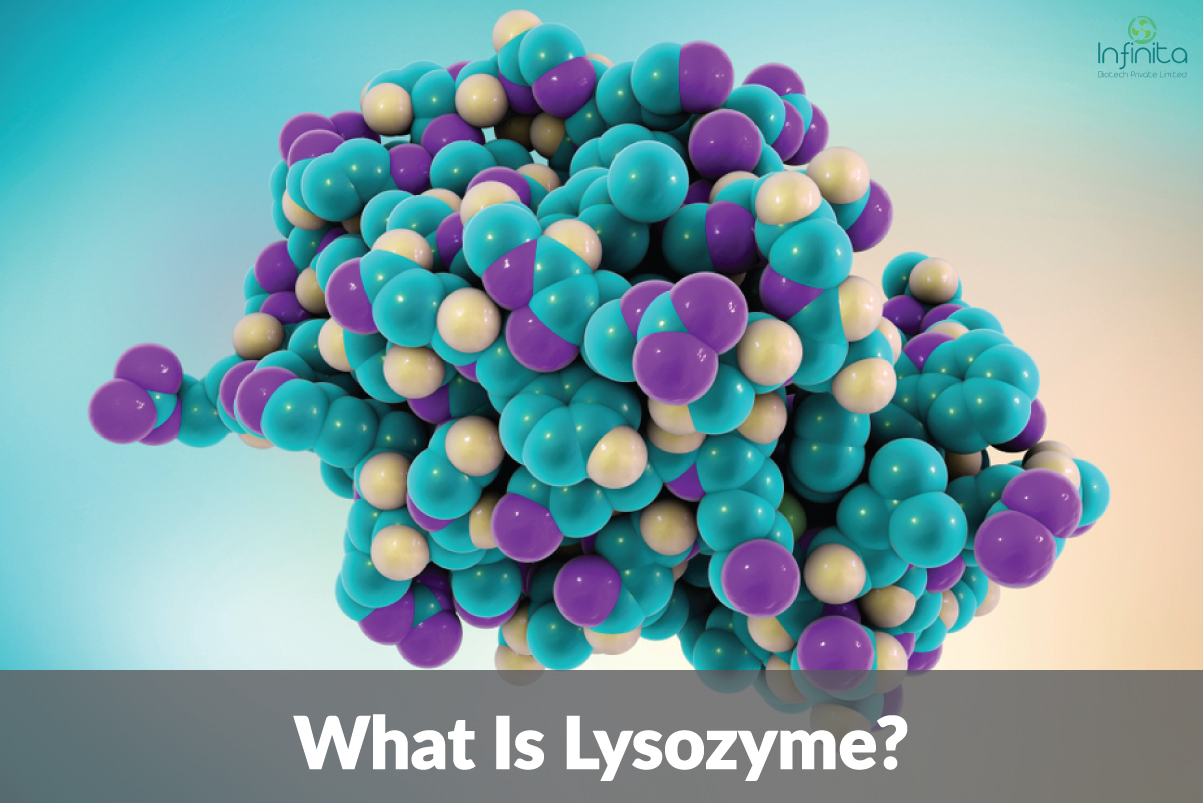
Lysozyme And Its Uses In Pharmaceutical Industry
How Is Lysozyme Enzyme Used In Pharmaceutical Industry?
Lysozyme, additionally referred to as lysozyme or N-acetylmuramide glycanhydrolase is Associate in Nursing antimicrobial catalyst created by animals that forms a part of the innate system. Lysozyme may be an organic compound hydrolase that catalyses the reaction of one,4-beta-linkages between N-acetylmuramic acid and N-Acetyl-D-glucosamine residues in peptidoglycan, that is that the major element of gram-positive microorganism semipermeable membrane. This reaction successively compromises the integrity of microorganism cell walls inflicting lysis of the microorganism.
Lysozyme enzyme is abundant in secretions including tears, saliva, human milk, and mucus. It is also present in cytoplasmic granules of the macrophages and the polymorphonuclear neutrophils(PMNs). Large amounts of muramidase are found in fixings. C-type lysozymes are closely related to alpha-lactalbumin in sequence and structure, making them part of the same glycoside hydrolase family 22. In humans, the C-type muramidase catalyst is encoded by the LYZ sequence.
Lysozyme is thermally stable, with a melting point reaching up to 72 ℃ at pH 5.0. However, in human milk, it loses activity terribly quickly at that temperature. Its isoelectric point is 11.35. Lysozyme enzyme can survive in a large range of pH (6-9).
Function And Mechanism
The enzyme functions by attacking, hydrolysing, and breaking glycosidic bonds in peptidoglycans. The catalyst may break glycosidic bonds in polyose, although not as effective as true chitinases.
Lysozymes active site binds the peptidoglycan molecule in the prominent cleft between its two domains. It attacks peptidoglycans (found within the cell walls of microorganism, particularly gram-positive bacteria), its natural substrate, between N-acetylmuramic acid (NAM) and the fourth carbon atom of N-acetylglucosamine (NAG).
Shorter saccharides like oligosaccharide have additionally shown to be viable substrates however via Associate in Nursing intermediate with an extended chain. Chitin has also been shown to be a viable lysozyme substrate. Artificial substrates have also been developed and used in lysozyme enzyme.
Mechanism
Phillips
The Phillips Mechanism planned that the enzyme’s chemical action power came from each steric strain on the sure substrate Associate in Nursing electricity stabilisation of an oxo-carbeniumintermediate. From X-ray crystallographic information, Phillips planned the site of the catalyst, wherever a hexasaccharide binds. The lysozyme distorts the fourth sugar (in the D or -1 subsite) in the hexasaccharide into a half-chair conformation. In this stressed state, the glycosidic bond is more easily broken. An ionic intermediate containing an oxo-carbeniumis created as a result of the glycosidic bond breaking. Thus distortion inflicting the substrate molecule to adopt a strained conformation like that of the transition state can lower the energy barrier of the reaction. The planned oxo-carbonium intermediate was imagined to be electrostatically stable by aspartate and salt residues within the site. The electricity stabilisation argument was supported comparison to bulk water, the reorientation of water dipoles can cancel out the stabilising energy of charge interaction. In that model, the enzyme acts as a super-solvent, which fixes the orientation of ion pairs and provides super-solvation (very good stabilisation of ion pairs), and especially lower the energy when to ions are close to each other.
The rate-determining step(RDS) during this mechanism is expounded to the formation of the oxo-carbenium intermediate. There were some contradictory results to point the precise RDS. By tracing the formation of product (p-nitrophenol), it was discovered that the RDS can change over different temperatures, which was a reason for those contradictory results. At a higher temperature the RDS is the formation of glycosyl-enzyme intermediate and at a lower temperature the breakdown of that intermediate.
Koshland
In Associate in Nursing early dialogue in 1969, a scientist proposed a covalent mechanism for lysozyme based on kinetic isotope effect, but for a long time, the ionic mechanism was more accepted. In 2001, a revised mechanism was planned by via a valency however not ionic intermediate. Evidence from ESI-MS analysis indicated a covalent intermediate. A 2-fluoro substituted substrate was used to lower the reaction rate and accumulate an intermediate for characterisation. The amino acid side-chains glutamic acid 35 (Glu35) and aspartate 52 (Asp52) have been found to be critical to the activity of this enzyme. Glu35 acts as a nucleon donor to the glycosidic bond, cleaving the C-O bond in the substrate, whereas Asp52 acts as a nucleophile to generate a glycosyl-enzyme intermediate. The Glu35 reacts with water to create hydroxide ion, a stronger nucleophile than water, which then attacks the glycosyl-enzyme intermediate, to give the product of hydrolysis and leaving the enzyme unchanged. This valency mechanism was named when Koshland, who first proposed this type of mechanism.
More recently, quantum mechanics/ molecular mechanics (QM/MM) molecular dynamics simulations have been using the crystal of HEWL and predict the existence of a covalent intermediate. Evidence for the ESI-MS and X-ray structures indicate the existence of valency intermediate but primarily rely on using a less active mutant or non-native substrate. Thus, QM/MM molecular dynamics provides the distinctive ability to directly investigate the mechanism of wild-type HEWL and native substrate. The calculations disclosed that the valency intermediate from the Koshland mechanism is ~30 kcal/mol a lot of stable than the ionic intermediate from the Phillips mechanism. These calculations demonstrate that the ionic intermediate is very energetically unfavourable and also the valency intermediates discovered from experiments victimisation less active mutant or non-native substrates give helpful insight into the mechanism of wild-type HEWL.
Inhibition
Imidazole derivatives can form a charge-transfer complex with some residues (in or outside active centre) to achieve a competitive inhibition of lysozyme. In Gram-negative bacteria, the lipopolysaccharide acts as a non-competitive inhibitor by highly-favoured binding with lysozyme.
Non-enzymatic Action
Despite the fact that enzymatic activity of an enzyme has been imagined to play a key role for its bactericide properties, evidence of its non-enzymatic action was has also been reported. For example, blocking the catalytic activity of lysozyme by mutation of critical amino acid in the active site (52-Asp -> 52-Ser) does not eliminate its antimicrobial activity. The lectin-like ability of an enzyme to acknowledge microorganism sugar substance while not a lytic activity was rumoured for oligosaccharide associated with lipopolysaccharide of enteric pneumonia. Also, lysozyme interacts with antibodies and T-cell receptors.
Enzyme Conformation Changes
Lysozyme exhibits 2 conformations: An open active state and a closed inactive state. The catalytic relevance was examined with single-walled carbon nanotubes (SWCN) field effect transistors (FETs), where a singular lysozyme was bound to the SWCN FET. Electronically monitoring the lysozyme showed two conformations, an open active site, and a closed inactive site. In its active state lysozyme is able to progressively hydrolyse its substrate, breaking on average 100 bonds at a rate of 15 per second. In order to bind a new substrate and move from the closed inactive state to the open active state requires two conformation step changes, while inactivation requires one step.
Role In Disease And Therapy
Lysozyme is part of the innate immune system. Reduced lysozyme levels have been associated with bronchopulmonary dysplasia in newborns. Piglets fed with human lysozyme milk can recover from diarrhoeal disease caused by E. coli faster. The concentration of lysozyme in human milk is 1,600 to 3,000 times greater than the concentration in livestock milk. Human enzyme is additional active than hen fixings enzyme. A transgenic line of goats (with a founder named “Artemis”) was developed to produce milk with human lysozyme to protect children from diarrhoea if they can’t get the benefits of human breastfeeding.
Since lysozyme is a natural form of protection from Gram-positive pathogens like Bacillus and Streptococcus, it plays an important role in the immunology of infants in human milk feeding. Whereas the skin may be a protecting barrier thanks to its condition and acidity, the conjunctiva (membrane covering the eye) is, instead, protected by secreted enzymes, mainly lysozyme and defensin. However, when these protective barriers fail, conjunctivitis results.
In sure willcers (especially myelomonocytic leukaemia) excessive production of enzyme by cancer cells can cause hepatotoxic levels of an enzyme within the blood. High lysozyme blood levels can lead to kidney failure and low blood potassium, conditions that may improve or resolve with treatment of the primary malignancy.
Serum lysozyme is much less specific for the diagnosis of sarcoidosis than serum angiotensin-converting enzyme; however, since it is more sensitive, it is used as a marker of sarcoidosis disease activity and is suitable for disease monitoring in proven cases.
Chemical Synthesis
The first chemical synthesis of an enzyme super molecule was tried by academic. George W. Kenner and his group at the University of Liverpool in England. This was finally achieved in 2007 by Steve Kent at the University of Chicago UN agency created an artificial purposeful enzyme molecule.
LYSOZYME
It acts as an anti-microbial agent.

Antimicrobial
Properties

Alternative To
Chemical Antibiotics

Boost Immunity
System
Related Articles
How Pharmaceuticals-Enzymes Are Revolutionizing Medicine?
Introduction Enzymes, long recognized for their pivotal roles in biological systems, are now at the forefront of medical innovations. From diagnostics to therapeutics, pharmaceutical enzymes are revolutionizing the way diseases are detected, treated, and managed....
Bromelain Enzyme: Uses and Benefits
Bromelain is a combination of enzymes present in the pulp and stem part of the Pineapple Plant or Ananas comosus. Bromelain, which is rich in dietary fibre, is a proteolytic enzyme that falls in the category of enzymes that assist in protein digestion. Bromelain...

Lysozyme And Its Uses In Pharmaceutical Industry
How Is Lysozyme Enzyme Used In Pharmaceutical Industry?
Lysozyme, additionally referred to as lysozyme or N-acetylmuramide glycanhydrolase is Associate in Nursing antimicrobial catalyst created by animals that forms a part of the innate system. Lysozyme may be an organic compound hydrolase that catalyses the reaction of one,4-beta-linkages between N-acetylmuramic acid and N-Acetyl-D-glucosamine residues in peptidoglycan, that is that the major element of gram-positive microorganism semipermeable membrane. This reaction successively compromises the integrity of microorganism cell walls inflicting lysis of the microorganism.
Lysozyme enzyme is abundant in secretions including tears, saliva, human milk, and mucus. It is also present in cytoplasmic granules of the macrophages and the polymorphonuclear neutrophils(PMNs). Large amounts of muramidase are found in fixings. C-type lysozymes are closely related to alpha-lactalbumin in sequence and structure, making them part of the same glycoside hydrolase family 22. In humans, the C-type muramidase catalyst is encoded by the LYZ sequence.
Lysozyme is thermally stable, with a melting point reaching up to 72 ℃ at pH 5.0. However, in human milk, it loses activity terribly quickly at that temperature. Its isoelectric point is 11.35. Lysozyme enzyme can survive in a large range of pH (6-9).
Function And Mechanism
The enzyme functions by attacking, hydrolysing, and breaking glycosidic bonds in peptidoglycans. The catalyst may break glycosidic bonds in polyose, although not as effective as true chitinases.
Lysozymes active site binds the peptidoglycan molecule in the prominent cleft between its two domains. It attacks peptidoglycans (found within the cell walls of microorganism, particularly gram-positive bacteria), its natural substrate, between N-acetylmuramic acid (NAM) and the fourth carbon atom of N-acetylglucosamine (NAG).
Shorter saccharides like oligosaccharide have additionally shown to be viable substrates however via Associate in Nursing intermediate with an extended chain. Chitin has also been shown to be a viable lysozyme substrate. Artificial substrates have also been developed and used in lysozyme enzyme.
Mechanism
Phillips
The Phillips Mechanism planned that the enzyme’s chemical action power came from each steric strain on the sure substrate Associate in Nursing electricity stabilisation of an oxo-carbeniumintermediate. From X-ray crystallographic information, Phillips planned the site of the catalyst, wherever a hexasaccharide binds. The lysozyme distorts the fourth sugar (in the D or -1 subsite) in the hexasaccharide into a half-chair conformation. In this stressed state, the glycosidic bond is more easily broken. An ionic intermediate containing an oxo-carbeniumis created as a result of the glycosidic bond breaking. Thus distortion inflicting the substrate molecule to adopt a strained conformation like that of the transition state can lower the energy barrier of the reaction. The planned oxo-carbonium intermediate was imagined to be electrostatically stable by aspartate and salt residues within the site. The electricity stabilisation argument was supported comparison to bulk water, the reorientation of water dipoles can cancel out the stabilising energy of charge interaction. In that model, the enzyme acts as a super-solvent, which fixes the orientation of ion pairs and provides super-solvation (very good stabilisation of ion pairs), and especially lower the energy when to ions are close to each other.
The rate-determining step(RDS) during this mechanism is expounded to the formation of the oxo-carbenium intermediate. There were some contradictory results to point the precise RDS. By tracing the formation of product (p-nitrophenol), it was discovered that the RDS can change over different temperatures, which was a reason for those contradictory results. At a higher temperature the RDS is the formation of glycosyl-enzyme intermediate and at a lower temperature the breakdown of that intermediate.
Koshland
In Associate in Nursing early dialogue in 1969, a scientist proposed a covalent mechanism for lysozyme based on kinetic isotope effect, but for a long time, the ionic mechanism was more accepted. In 2001, a revised mechanism was planned by via a valency however not ionic intermediate. Evidence from ESI-MS analysis indicated a covalent intermediate. A 2-fluoro substituted substrate was used to lower the reaction rate and accumulate an intermediate for characterisation. The amino acid side-chains glutamic acid 35 (Glu35) and aspartate 52 (Asp52) have been found to be critical to the activity of this enzyme. Glu35 acts as a nucleon donor to the glycosidic bond, cleaving the C-O bond in the substrate, whereas Asp52 acts as a nucleophile to generate a glycosyl-enzyme intermediate. The Glu35 reacts with water to create hydroxide ion, a stronger nucleophile than water, which then attacks the glycosyl-enzyme intermediate, to give the product of hydrolysis and leaving the enzyme unchanged. This valency mechanism was named when Koshland, who first proposed this type of mechanism.
More recently, quantum mechanics/ molecular mechanics (QM/MM) molecular dynamics simulations have been using the crystal of HEWL and predict the existence of a covalent intermediate. Evidence for the ESI-MS and X-ray structures indicate the existence of valency intermediate but primarily rely on using a less active mutant or non-native substrate. Thus, QM/MM molecular dynamics provides the distinctive ability to directly investigate the mechanism of wild-type HEWL and native substrate. The calculations disclosed that the valency intermediate from the Koshland mechanism is ~30 kcal/mol a lot of stable than the ionic intermediate from the Phillips mechanism. These calculations demonstrate that the ionic intermediate is very energetically unfavourable and also the valency intermediates discovered from experiments victimisation less active mutant or non-native substrates give helpful insight into the mechanism of wild-type HEWL.
Inhibition
Imidazole derivatives can form a charge-transfer complex with some residues (in or outside active centre) to achieve a competitive inhibition of lysozyme. In Gram-negative bacteria, the lipopolysaccharide acts as a non-competitive inhibitor by highly-favoured binding with lysozyme.
Non-enzymatic Action
Despite the fact that enzymatic activity of an enzyme has been imagined to play a key role for its bactericide properties, evidence of its non-enzymatic action was has also been reported. For example, blocking the catalytic activity of lysozyme by mutation of critical amino acid in the active site (52-Asp -> 52-Ser) does not eliminate its antimicrobial activity. The lectin-like ability of an enzyme to acknowledge microorganism sugar substance while not a lytic activity was rumoured for oligosaccharide associated with lipopolysaccharide of enteric pneumonia. Also, lysozyme interacts with antibodies and T-cell receptors.
Enzyme Conformation Changes
Lysozyme exhibits 2 conformations: An open active state and a closed inactive state. The catalytic relevance was examined with single-walled carbon nanotubes (SWCN) field effect transistors (FETs), where a singular lysozyme was bound to the SWCN FET. Electronically monitoring the lysozyme showed two conformations, an open active site, and a closed inactive site. In its active state lysozyme is able to progressively hydrolyse its substrate, breaking on average 100 bonds at a rate of 15 per second. In order to bind a new substrate and move from the closed inactive state to the open active state requires two conformation step changes, while inactivation requires one step.
Role In Disease And Therapy
Lysozyme is part of the innate immune system. Reduced lysozyme levels have been associated with bronchopulmonary dysplasia in newborns. Piglets fed with human lysozyme milk can recover from diarrhoeal disease caused by E. coli faster. The concentration of lysozyme in human milk is 1,600 to 3,000 times greater than the concentration in livestock milk. Human enzyme is additional active than hen fixings enzyme. A transgenic line of goats (with a founder named “Artemis”) was developed to produce milk with human lysozyme to protect children from diarrhoea if they can’t get the benefits of human breastfeeding.
Since lysozyme is a natural form of protection from Gram-positive pathogens like Bacillus and Streptococcus, it plays an important role in the immunology of infants in human milk feeding. Whereas the skin may be a protecting barrier thanks to its condition and acidity, the conjunctiva (membrane covering the eye) is, instead, protected by secreted enzymes, mainly lysozyme and defensin. However, when these protective barriers fail, conjunctivitis results.
In sure willcers (especially myelomonocytic leukaemia) excessive production of enzyme by cancer cells can cause hepatotoxic levels of an enzyme within the blood. High lysozyme blood levels can lead to kidney failure and low blood potassium, conditions that may improve or resolve with treatment of the primary malignancy.
Serum lysozyme is much less specific for the diagnosis of sarcoidosis than serum angiotensin-converting enzyme; however, since it is more sensitive, it is used as a marker of sarcoidosis disease activity and is suitable for disease monitoring in proven cases.
Chemical Synthesis
The first chemical synthesis of an enzyme super molecule was tried by academic. George W. Kenner and his group at the University of Liverpool in England. This was finally achieved in 2007 by Steve Kent at the University of Chicago UN agency created an artificial purposeful enzyme molecule.
0 Comments
Submit a Comment
You must be logged in to post a comment.
LYSOZYME
It acts as an anti-microbial agent.

Antimicrobial Properties

Alternative To Chemical Antibiotics

Boost Immunity System
How Pharmaceuticals-Enzymes Are Revolutionizing Medicine?
Introduction Enzymes, long recognized for their pivotal roles in biological systems, are now at the forefront of medical innovations. From diagnostics to therapeutics, pharmaceutical enzymes are revolutionizing the way diseases are detected, treated, and managed....
Bromelain Enzyme: Uses and Benefits
Bromelain is a combination of enzymes present in the pulp and stem part of the Pineapple Plant or Ananas comosus. Bromelain, which is rich in dietary fibre, is a proteolytic enzyme that falls in the category of enzymes that assist in protein digestion. Bromelain...
Nutraceutical Enzymes And Their Benefits
It is common knowledge that humans have always identified natural products as the main source of nutrition. Dietary requirements have always been the point of focus when it comes to nutrition. It is also interesting to note that the field of biomedicals has found out...




0 Comments